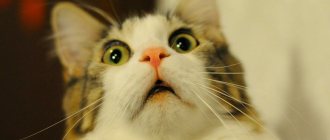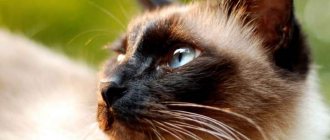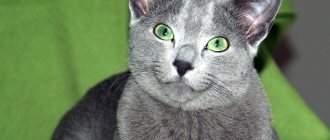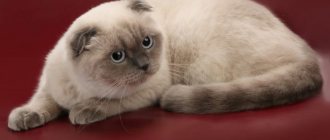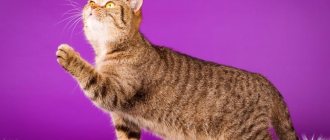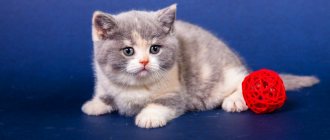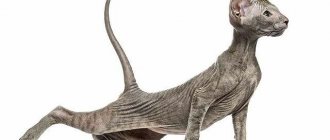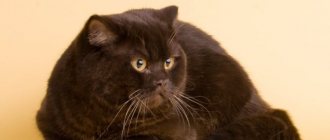All about the Russian Blue cat breed
Author Marina Kuvaeva Reading time 13 min.
.5k. Published 02/07/2020 Updated 02/08/2020 The Russian Blue cat is an elegant feline with special plush fur and expressive green eyes. This description is complemented by her aristocratic character, manners and independent disposition.
Russian blue cat.
Historical reference
If we talk about the real origin of the Russian Blue, then its history is shrouded in great mystery, and it is still not possible to reveal it:
The formation of a new breed standard dates back to 1965, some of its points are still relevant today.
Today, nurseries of Russian blue cats are located in many cities and countries, and there is even an exchange between European and Russian ones, which allows us to conclude that the breed is firmly rooted.
History of the origin of the breed
Like many other cats, the first kittens in the breed were born spontaneously, thanks to a successful random combination of genes. There is no exact information about this breed; it is impossible to say when and where exactly they were born. That is why the history of their appearance is shrouded in various legends, some of which contradict each other. The most common version says that they were born in the mid-19th century. British sailors brought kittens to Arkhangelsk.
In appearance, they were very similar to the British, but had some differences in the structure of the shape of the skull and torso. The Russian blue cat reached a new level of its distribution thanks to a breeder from England. These animals received their first signs in 1893, when kittens were crossed with other cat breeds. These attempts did not bring success. The kittens were obtained without the characteristic plush fur, which stands out against the background of representatives of other breeds. It was decided to start breeding a purebred breed. They received their official recognition in the 30s of the last century. Felinologists and breeders began breeding with special effort after the end of World War II.
Interesting read: everything about exotic cats.
Characteristics of this breed
Among the features of the breed:
Important! Cats do not tolerate family conflicts well, which negatively affect their psyche.
Shedding
Pets shed lightly, almost imperceptibly and evenly throughout the year. Excessive hair loss is possible due to poor diet and stress.
Allergy
Cats of this breed are considered hypoallergenic, that is, slightly allergenic (the cat's fur will be less common and less likely to provoke allergies).
If someone in the family suffers from allergies and has positive antibody titers for cat fur, then purchasing a cat of any breed will provoke allergic reactions.
External features and standard
Description of the Russian Blue cat breed is characterized by the following requirements:
- the skull has a pronounced chin, flat forehead, straight nose;
- flat, high-set cheekbones;
- pronounced whisker pads;
- wedge-shaped muzzle;
- large ears with sharp tips and a wide base;
- large almond-shaped green eyes;
- short, silky soft coat;
- uniform blue color with a silver tint at the ends of the hairs;
- medium-sized body with pronounced muscularity;
- Long neck;
- long slender legs.
This cat breed takes part in all exhibitions, international competitions and other felinological events. The size and weight of the Russian Blue cat is average for cats. Body weight can be 3.5-5 kg.
How long do Russian blue cats live?
The life expectancy of representatives of this breed depends on the individual characteristics of the animal, living conditions, care and feeding. But on average, Russian Blue cats live about 20 years.
The eyes of the Russian Blue cat are emerald green.
Breed varieties
The Russian Blue cat has several types of breed, each of which has its own standards. These cats are divided by breeding geography as follows:
- North American Russian Blue cat, recognized in the TIKA and CFA felinological systems. It is distinguished by a more oriental appearance, an animal with a wedge-shaped skull, unfolded ears, and double coat.
- European or WCF - the pet has a flat skull, thick fur, colored a uniform blue color with a characteristic silver tint.
- English standard (recognized by the GCCF). These cats have a wedge-shaped, shortened head. The coat is light blue, thick and dense.
- Scandinavian type, close to the standards of the North American cat.
Chart of characteristics of the 4 types of Russian Blue cats.
Sometimes the Russian Blue cat changes color. The silvery tint of the coat can change under the influence of external factors: excess heat, frequent exposure to direct sunlight, oversaturation of the diet with copper and iron.
Kittens may have rings on their tails that disappear as they grow older. This is not considered a disadvantage. In addition to the Russian Blue, there are also Russian White and Russian Black cats. They are less common than their silver-blue counterparts.
Eyes of a Russian Blue cat.
Differences between Russian Blue and British Blue
The only thing that the Russian Blue and British breeds have in common is their color. An inexperienced person may confuse them, especially if they are dealing with a small kitten. There are several significant differences between these breeds:
- Eyes. The Russian Blue cat is distinguished by an unusual shade of green eyes, reminiscent of emerald. The British eyes are copper or yellow.
- Wool. The Russian Blue cat is soft to the touch, fluffy, and the hairs lie tightly to the body. The British fur coat is more like plush.
- Body. The British have a more massive, dense body. In the Russian breed it is rather fragile, elegant, and graceful.
You can easily distinguish cats of these breeds by the shape of their skull. In the British, it has a rounded shape, a muzzle with pronounced thick cheeks. The head of the Russian Blue cat is more reminiscent of the standard cat shape, with a pointed muzzle.
Material on the topic: popular colors of the Scottish cat breed.
Appearance
Russian Blue Kitten
The Russian Blue cat is the epitome of grace and sophistication. Representatives of this clan are easily identified by their graceful posture and stately “ballet” gait. The second identifying feature of the breed is its dense velvet coats of bluish-ash color. It is thanks to the soft fur, distant from the body, that the silhouette of the animal acquires additional expressiveness and exquisite charm.
Depending on the place of breeding, there are three main types of appearance of Arkhangelsk blues:
- American (TICA standard) - oriental type, characterized by a wedge-shaped skull, large unfolded ears and a double coat of bright blue color;
- European (WCF standard) - with a flat skull and thick coat of a uniform blue tone with a silver tint;
- English (GCCF standard) - with a short wedge-shaped head and dense light blue fur covered with a silvery “patina” (silvering).
Head
According to the standard approved by the World Cat Federation (WCF), representatives of the Russian Blue breed must have a flat, moderately elongated skull and a straight nose, smoothly turning into the same even forehead and forming a slight bulge at the level of the eyebrows. The chin should be strong and rounded. The whisker pads are distinct and moderately convex. The tone of the lobe is gray-blue.
American type Russian Blue cat
European type of Russian Blue cat
English type Russian Blue cat
Eyes
They have a beautiful almond-shaped shape. Cats of this breed are distinguished by a special shade of eyes - they are bright green.
Ears
Quite large, tilted forward. The tip of the ear looks slightly pointed in “Americans” and more rounded in “Europeans”. The ear tissue is thin and elastic. The inner part of the ear funnel is slightly pubescent.
Neck
The neck of the Russian Blue cat is elongated and graceful.
Body
The Russian Blue cat is a harmonious combination of stunning grace and a strong, muscular body. The pets' limbs are long, their paws are neat and rounded. The tips of the paws are narrow in shape. This cat breed has a medium body size.
Limbs
Legs are long and straight. The Russian Blue's paws are oval, with soft, elastic pads of lilac-pink color. The “Americans” have pinkish-beige pads.
Plush paws
Tail
The long tail is slightly widened at the base. Closer to the tip it narrows and becomes rounded.
Wool
Russian Blue kittens are a short-haired breed. Moreover, they are tactilely reminiscent of plush toys - their fur is distinguished by its smoothness and pleasant tactile sensations. The coat is close-lying and has a thick undercoat.
Color
The ideal Russian Blue, from the point of view of the WCF Commission, should have a uniform mid-tone blue color with a slight silver tipping. The TICA standard prescribes a bright blue color type with a subtle silver tint for its pets.
Possible defects
One of the most common defects is a discrepancy between the coat color and the generally accepted standard. For example, even a purebred cat is capable of producing offspring, among whom will be a baby with a spotted coat. The reason for such a marriage is the play of genes, so it is almost impossible to predict the likelihood of the birth of “wrong” kittens.
Serious disadvantages of the breed include a knobby, kinked tail, an incorrect bite, and bulging or too deep-set eyes. Championship is not possible for individuals with a sagging spine, strabismus, or fur that fits tightly to the body. Polydacts, cats that have undergone onychectomy (declaw surgery), animals with color defects (spots on the fur with an area of more than 1 cm) and aggressive individuals are subject to unconditional disqualification.
Pet character and temperament
The Russian Blue breed is a type of cat with which there are no difficulties or problems. Whims, excessive self-indulgence, malicious sabotage - all this is not about them. Instead, these cats have innate intelligence, sensitivity, and compliance with the established rules of behavior accepted in the given territory. They are loyal to children's pranks with them, while understanding that they are dealing with a child and do not let out their claws.
However, it is still not worth leaving them alone. They get along with other animals if the former do not show aggression, arrogance or provocation. Any place for these cats is the top shelves of cabinets, at a height of at least 1.5 meters from the floor. They perceive affection from a person very well, but they will not allow themselves to be squeezed. In their souls they still have the instincts of an independent predatory animal.
Getting a mouse, a pet hamster or a parrot is a matter of principle. The character of the Russian Blue cat has a certain peculiarity - the need to hunt in a playful way. In a city apartment, the object of hunting will be flies, small insects or imaginary objects of hunting. While chasing them, cats often lose their vigilance, which often leads to them falling out of windows, which can cause serious injury or even death.
Basic moments
- A distinctive feature of the breed is its reckless love for high jumps, so it is better not to keep vases and other fragile objects in the room where the animal lives.
- Russian Blue cats are extremely clean, so they take a litter box that is left out late or poorly washed as a personal insult.
- Adult animals are cautious and extremely shy. When a stranger appears in the house, they try to move away or hide.
- Cats are quite independent. In the absence of proper attention from the owner, they are able to entertain themselves.
- Both kittens and adults love affection, but do not suffer from excessive intrusiveness.
- They are erudite, have a stable psyche, and easily learn everything new.
- Thanks to the dense, thick coat, glycoproteins from the cat’s skin almost never enter the environment, which makes the breed practically safe for allergy sufferers.
- Russian Blue Murks have a very quiet voice, so they meow inaudibly.
- They are distinguished by good health. With proper care they can live up to 20 years or more. History has recorded cases when individual individuals managed to celebrate their 25th anniversary.
- Animals do not tolerate intra-family conflicts well. Frequent quarrels between household members can turn a Russian Blue cat into a nervous, intimidated and inadequate creature.
- From 2 to 4 kittens are born in one litter, so in reputable nurseries the offspring are distributed among potential buyers long before birth.
Russian blue cats are plush intellectuals who feel equally at home in a modest city apartment and in royal chambers. Everything about these graceful, majestic creatures is beautiful, from their ballet posture to their hypnotic, almost infernal gaze. Unobtrusive and delicate, they will not bother you with nightly “oratorios” and demands for every minute caresses. However, these furry nobles also do not intend to completely dissolve in the interests of the owner, because their purpose is to decorate, and not to brighten up life.
Education and physical activity
A kitten learns to go to the toilet from early childhood. As soon as he gets into his new home, he must immediately be introduced to the tray - put him inside for a few minutes and let him get used to it. Kittens usually get used to it easily and without much effort.
In the first days, the kitten should get used to its place of residence. The Russian Blue kitten is physically active. These pets are playful, active, mobile, even in adulthood. Children often receive various injuries due to careless games.
This breed will do well even in a medium-sized apartment. They don't need outdoor exercise. The Russian Blue will feel comfortable even in a small apartment, since the size of an adult animal is quite miniature. Despite the fact that such a pet will not require frequent walks, he is enthusiastic about fresh air, so it is important to ensure systematic ventilation of the room.
Playfulness and sociability
5
Accommodation and affection
3
Yellow eyes of Russian Blue.
If desired, the Russian Blue cat breed can be trained in some commands. Here you need to take turns, short training sessions accompanied by encouragement. You can't tease a kitten. The animal may get it wrong. It is not recommended to swing at your pet. You can use loud claps and a strict tone. You cannot give punishment retroactively; the cat will not understand why exactly it happened.
Material on the topic: all about the character and habits of Maine Coons.
Table: pros and cons of the Russian Blue breed
| Characteristic | pros | Minuses |
| Appearance | bright appearance, rare color, beautiful sea-colored eyes | in fact, the cat's fur may not be bluish, but simply gray |
| Character | accommodating, indulgent, shy character | the pet is a little cowardly, can hide in closets, etc. |
| Health | good health, strong immunity, no predisposition to genetic diseases identified | — |
| Kitten price | you can find kittens with a pedigree costing from 8 thousand rubles | in prestigious nurseries the price for 1 kitten can exceed 35 thousand rubles |
| Difficulties in content | the cat is not capricious, quickly gets used to the proposed conditions, does not require much | the animal is afraid of closed doors |
| Difficulties in breeding | gives birth independently and quickly, 3–4 kittens can be born in a litter | sometimes it is difficult to find a purebred partner |
Maintenance and care
The Russian Blue is a short-haired cat breed, but caring for them is complicated by the presence of a very thick, dense undercoat. Brushing should be done at least twice a week. It is advisable to use a furminator for this. Particular attention must be paid to the cat during the molting period. The kittens themselves are clean and can be washed no more than once every six months. Every two weeks it is necessary to clean the animal’s ears and eyes by wiping them with a moistened cotton pad. These cats are demanding about the cleanliness of their dishes. Their water or food bowls should always be kept perfectly clean. A kitten or cat should have the opportunity to express its energy. To do this, you can purchase a house that is better located at a height. Otherwise, he will climb on shelves or cabinets.
Russian white cat.
Interesting Facts
Over the years of the breed’s existence, many interesting things have been associated with it:
- Blue cats were regular participants in Harry Houdini's tricks. The legendary magician considered them the most intelligent and magnetic of all known breeds.
- Peter I was a passionate admirer of cats with an ash-blue coat. His pet, nicknamed Vaska, could move around the palace without hindrance.
- At first, representatives of the breed were nervous and timid, for which the Russian Blue was nicknamed the “wild gray rabbit.” As a result of targeted selection, this deficiency was eliminated.
How to choose the right food
You can feed your Russian Blue cat with prepared or natural food. The pet must receive premium, super-premium or holistic food. The composition of these feeds is balanced in composition, containing a sufficient amount of all substances necessary for the body, as well as the optimal amount of proteins, fats, and carbohydrates. Natural nutrition should contain:
- non-fatty meats, ideally rabbit, turkey or veal;
- meat by-products;
- boiled egg yolk;
- boiled varieties of sea fish;
- kefir, cottage cheese, other low-fat fermented milk products;
- boiled or raw vegetables;
- cereals
You should not give your pet smoked, fried, food with salt and spices.
What to feed
For small kittens, five meals a day are required; the frequency of food distribution is adjusted as the pet grows older. Thus, six-month-old animals should receive food 4 times a day, and cats that have reached the age of 1 year are fed in the morning and evening.
For the Russian Blue, high-quality food is very important, and therefore the diet will have to be thought out most carefully. When choosing a feeding method, you should pay attention to the following features:
There are a number of foods that a cat should not have in their diet, namely:
- smoked meat;
- sweets;
- corned beef;
- seasonings and spices;
- fried meat.
Health and illness
The average lifespan of a Russian Blue cat is 15 – 20 years. These kittens have good heredity and do not have any serious genetic diseases. However, they are prone to problems with the respiratory tract and digestive system. Such a phenomenon as food allergies is not uncommon for them. As you age and your metabolism slows, you may experience weight gain. In this case, you should limit your caloric intake.
Vaccinations and antiparasitic treatment
The first vaccinations are given at about two months of age. Typically, complex drugs are used for this purpose, causing stable immunity to:
- rhinotracheitis;
- calcivirus;
- rabies;
- herpes virus infection;
- panleukopenia.
After 4-5 weeks, kittens must be revaccinated, but with the addition of anti-rabies components. After this, vaccinations are given once a year. Vaccinations are mandatory and recommended.
A week before vaccination, the pet should receive antihelminthic medications. They are given once every three months. Adults once every six months, repeating the procedure after two weeks. As soon as the animal shows the first suspicious symptoms, you should immediately contact a veterinarian. You should not self-medicate or look for answers to questions on the Internet.
Sterilization and castration
If the animal lives in a city apartment and is not planned for breeding, it is better to sterilize it. This operation is performed over a period of 7-10 months. Do not confuse castration with sterilization - these are essentially different operations. Castration is the removal of the gonads from an animal, and sterilization is the tying of the spermatic cords in males or the fusion of the oviducts in females.
Adult blue cat.
How to choose a kitten
Shorthair Russian Blue cats are bred in many catteries; a sufficient number of breeders are engaged in them. Finding a suitable individual will not be difficult. When choosing a baby, it is recommended to pay attention to eye color. They should be emerald green in color. You should not take kittens with yellow irises, even if the breeder assures that they will turn green over time. The kitten's coat should have so-called silvering.
If there are inclusions of other colors, one should doubt the purity of its pedigree. The presence of stripes or tabbies is not a defect that will disappear with adulthood. The kitten must have clean eyes and ears. If a kitten runs away when new people appear, such individuals cannot be chosen either. A good reliable nursery will not sell its animals before three months. When choosing a nursery, it is important that it is registered with felinological organizations and has all the necessary documents.
How much do Russian Blue kittens cost?
Getting purebred kittens that can take part in exhibitions and breeding is a very difficult and expensive task. The average price for such kittens is 23,000-28,000 rubles. A kitten with an ideal pedigree can cost about 40,000. If we talk about individuals that are offered through advertisements on sales sites at a price of 3000-5000 rubles, most likely such kittens do not have any supporting documents, or they appeared as a result of an unplanned mating.
How to name a kitten
When choosing a nickname for your pet, it is important to take into account the nature of this breed. Its representatives are obedient, intelligent, affectionate, and are not inclined to mischief. At the same time, they have a certain touch of aristocracy and even elitism. The pet's name should suit all these characteristics. The table below shows popular names for cats.
Table of popular names for cats and cats.
How much does a kitten cost, a few words about the right choice
Representatives of this breed have different prices, and it all depends on a number of factors:
- presence of titled parents;
- pedigree;
- compliance with the breed standard criteria.
Without documentation, the cost of a kitten will be about 5,000 rubles, but no one here guarantees the purebred of the pet. The presence of various certificates significantly increases the cost of the animal and it starts from 20,000 rubles.
Recommend: Singaporean cat
If a person wants to choose a pet that can be taken to exhibitions or used for crossing, then it is necessary to contact a specialized nursery.
But here there are some nuances that you should focus on:
- conditions for keeping animals;
- appearance of kittens;
- the appearance of the parents;
- availability of documents.
If all of the above factors do not cause any complaints, then you can safely make a purchase.

